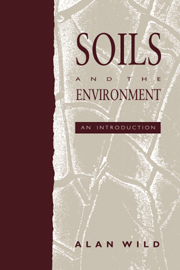Book contents
- Frontmatter
- Contents
- Preface
- Acknowledgements
- Units, symbols and general information
- 1 Introduction: soil in a natural and man-made environment
- A Soil properties and processes
- B Soils in relation to the environment
- 7 Soil as a medium for plant growth
- 8 Soil conditions and crop production
- 9 Soil acidification
- 10 Heavy metals and radionuclides in soil
- 11 Soils, the atmosphere, global warming and ozone depletion
- 12 Soil erosion and conservation
- 13 Soils in the environment: problems and solutions
- Suggestions for further reading
- Index
11 - Soils, the atmosphere, global warming and ozone depletion
Published online by Cambridge University Press: 06 January 2010
- Frontmatter
- Contents
- Preface
- Acknowledgements
- Units, symbols and general information
- 1 Introduction: soil in a natural and man-made environment
- A Soil properties and processes
- B Soils in relation to the environment
- 7 Soil as a medium for plant growth
- 8 Soil conditions and crop production
- 9 Soil acidification
- 10 Heavy metals and radionuclides in soil
- 11 Soils, the atmosphere, global warming and ozone depletion
- 12 Soil erosion and conservation
- 13 Soils in the environment: problems and solutions
- Suggestions for further reading
- Index
Summary
Introduction
The mean temperature of the Earth's surface is 288 K (15°C). It is kept at this temperature by the so-called greenhouse effect without which it would be about 34 degrees lower. There is concern, however, that higher concentrations of CO2 and other gases in the atmosphere will lead to higher temperatures at the Earth's surface, that is, to global warming. There is also concern that the emission of certain gases will decrease the layer of ozone in the stratosphere, which will lead to more ultraviolet light reaching the Earth's surface, as discussed in Section 11.3.
An important distinction has to be made between a greenhouse effect, which keeps the Earth's surface warm and at a roughly constant temperature, and an enhanced greenhouse effect, which results in global warming. The greenhouse effect is benign, but global warming is expected to lead to rising sea levels, changes of annual and seasonal rainfall at a regional scale, and to effects on vegetation systems and agriculture which are as yet uncertain. Rising sea levels will require substantial capital investment in barriers to prevent flooding and might cause serious loss of life, and a change of weather patterns might result in food shortages.
Although emission of CO2 from the burning of fossil fuels is the main cause of the problem, there is an appreciable flux of CO2 from the oxidation of soil organic matter and the burning of forests. Soil is also an important source of the greenhouse gases methane, CH4, and nitrous oxide, N2O.
- Type
- Chapter
- Information
- Soils and the Environment , pp. 211 - 232Publisher: Cambridge University PressPrint publication year: 1993



